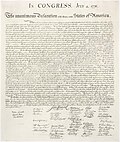Facsimile
Facsimile is a method of communication that involves the transmission of printed material, such as documents and photographs, over a distance. The term "facsimile" comes from the Latin fac simile, which means "make similar". This is because the goal of a facsimile is to reproduce a document as closely as possible to the original.
History[edit]
The concept of facsimile transmission has been around for over a century. The first facsimile system was developed in the mid-19th century by Scottish inventor Alexander Bain. Bain's system used a scanning mechanism to transmit images over telegraph wires.
In the 20th century, facsimile transmission became more common with the development of the fax machine. These machines scan a document, convert the information into a digital signal, and then transmit that signal over a phone line to another fax machine, which prints out a copy of the original document.
How it Works[edit]
A facsimile transmission involves several steps. First, the document to be transmitted is scanned by the sending fax machine. This machine converts the information on the document into a digital signal. This signal is then sent over a phone line to the receiving fax machine. The receiving machine decodes the signal and prints out a copy of the original document.
Uses[edit]
Facsimile transmission is used in a variety of settings. It is commonly used in business for the transmission of documents, such as contracts and invoices. It is also used in healthcare for the transmission of medical records and prescriptions. In addition, facsimile transmission is used in law enforcement for the transmission of fingerprints and other evidence.
Advantages and Disadvantages[edit]
One of the main advantages of facsimile transmission is that it allows for the quick and easy transmission of documents over a distance. This can be particularly useful in situations where a physical copy of a document is needed quickly.
However, there are also some disadvantages to facsimile transmission. One of the main disadvantages is that the quality of the transmitted document can be lower than the original. In addition, fax machines can be expensive to maintain and operate, and they require a dedicated phone line.
See Also[edit]
Ad. Transform your life with W8MD's Budget GLP-1 injections from $75


W8MD offers a medical weight loss program to lose weight in Philadelphia. Our physician-supervised medical weight loss provides:
- Weight loss injections in NYC (generic and brand names):
- Zepbound / Mounjaro, Wegovy / Ozempic, Saxenda
- Most insurances accepted or discounted self-pay rates. We will obtain insurance prior authorizations if needed.
- Generic GLP1 weight loss injections from $75 for the starting dose.
- Also offer prescription weight loss medications including Phentermine, Qsymia, Diethylpropion, Contrave etc.
NYC weight loss doctor appointmentsNYC weight loss doctor appointments
Start your NYC weight loss journey today at our NYC medical weight loss and Philadelphia medical weight loss clinics.
- Call 718-946-5500 to lose weight in NYC or for medical weight loss in Philadelphia 215-676-2334.
- Tags:NYC medical weight loss, Philadelphia lose weight Zepbound NYC, Budget GLP1 weight loss injections, Wegovy Philadelphia, Wegovy NYC, Philadelphia medical weight loss, Brookly weight loss and Wegovy NYC
|
WikiMD's Wellness Encyclopedia |
| Let Food Be Thy Medicine Medicine Thy Food - Hippocrates |
Medical Disclaimer: WikiMD is not a substitute for professional medical advice. The information on WikiMD is provided as an information resource only, may be incorrect, outdated or misleading, and is not to be used or relied on for any diagnostic or treatment purposes. Please consult your health care provider before making any healthcare decisions or for guidance about a specific medical condition. WikiMD expressly disclaims responsibility, and shall have no liability, for any damages, loss, injury, or liability whatsoever suffered as a result of your reliance on the information contained in this site. By visiting this site you agree to the foregoing terms and conditions, which may from time to time be changed or supplemented by WikiMD. If you do not agree to the foregoing terms and conditions, you should not enter or use this site. See full disclaimer.
Credits:Most images are courtesy of Wikimedia commons, and templates, categories Wikipedia, licensed under CC BY SA or similar.
Translate this page: - East Asian
中文,
日本,
한국어,
South Asian
हिन्दी,
தமிழ்,
తెలుగు,
Urdu,
ಕನ್ನಡ,
Southeast Asian
Indonesian,
Vietnamese,
Thai,
မြန်မာဘာသာ,
বাংলা
European
español,
Deutsch,
français,
Greek,
português do Brasil,
polski,
română,
русский,
Nederlands,
norsk,
svenska,
suomi,
Italian
Middle Eastern & African
عربى,
Turkish,
Persian,
Hebrew,
Afrikaans,
isiZulu,
Kiswahili,
Other
Bulgarian,
Hungarian,
Czech,
Swedish,
മലയാളം,
मराठी,
ਪੰਜਾਬੀ,
ગુજરાતી,
Portuguese,
Ukrainian




